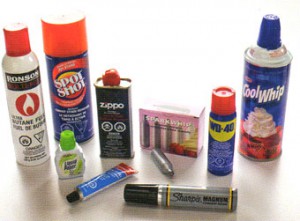Inhalants

Inhalants are drugs that are especially insidious exactly because they are so easily and legally obtained. An inhalant is basically a chemical compound that produces a vapor that can be inhaled, and that can produce a mind-altering effect. Most inhalants are legal substances bought at the grocery store, such as aerosol hairspray, white-out and markers. Even though they are easily bought and used, inhalant use can have some fairly severe effects. While inhalant use is mostly confined to teenagers, 22.8 million Americans have used inhalants, including adults.
Types of inhalants
There are four main types of inhalants: volatile solvents, gases, aerosols and nitrites.
Volatile solvents. Inhalants that fall under this category are items that are liquid, but that vaporize (put off a sort of “gas” or “strong smell”) at room temperature. Paint thinners, correction fluid, markers, gasoline and dry-cleaning fluids are all volatile solvent inhalants.
Gases. Gases are pretty much in vapor form at room temperature and otherwise. Sources for household gases used as inhalants include butane lighters, refrigerants, whipped cream dispensers and propane tanks. Medical gases can also be used as gas inhalants: chloroform, ether and nitrous oxide.
Aerosols. These are sprays that have propellants that push the product out. Spray paint, hairspray, vegetable oil cook sprays, air fresheners and fabric protection sprays are all examples of aerosol inhalants.
Nitrites. These, commonly known as “poppers” or “snappers” are a little harder to get. They include such inhalants as isobutyl nitrite, isoamyl nitrite and cyclohexyl nitrite.
Health effects of inhalant use
There are very real health effects associated with inhalant use. About 9,275 emergency room visits are due to inhalant use every year, but that does not fully allow for a grasp of the problem. The effects of inhalant use tend to add up, as a user becomes addicted. One of the fastest effects is a rapid high that is very similar to the feeling of being drunk: excitation, followed by drowsiness, lightheadedness and agitation. Nearly all inhalants can produce loss of sensation and unconsciousness when enough is inhaled. Continued inhalant use can lead to heart, liver, kidney and lung damage. Depression, disorientation, unhealthy weight loss, irritability and lack of coordination are all effects stemming from prolonged inhalant abuse.
Inhalant use statistics
Inhalant use represents a small portion of drug addiction (only 0.1 percent of treatment admissions), but it is nevertheless very real. Inhalant abuse is primarily noted among teenagers and young adults. Here are statistics regarding inhalant use:
- 68.7 percent of treated inhalant users are male
- 67.4 percent of inhalant users admitted to treatment are white
- The average age of someone admitted to treatment programs for inhalants is 24
- Nearly 2.3 million people reported inhalant use in the past year
- About 638,000 people admit to using inhalants in the past month
Street names for inhalants
There are various names for inhalants on the street. Here are some of them:
- Air blast
- Poor man’s pot
- Climax = isobutyl nitrate
- Gluey = sniffing glue
- Buzz bomb = nitrous oxide
The act of using inhalants is designated as gladding or bagging, and an inhalant user is galled a huffer.
Inhalants Main source material:
- “Inhalants,” Drug Facts. Office of National Drug Control Policy. [Online.]





